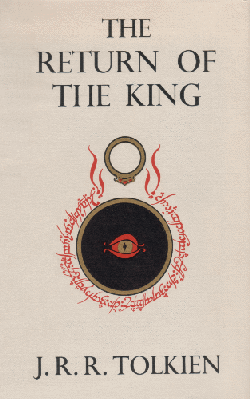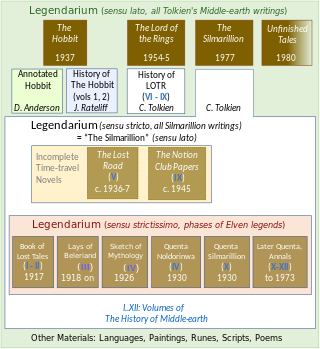
Arwen Undómiel is a fictional character in J. R. R. Tolkien's Middle-earth legendarium. She appears in the novel The Lord of the Rings. Arwen is one of the half-elven who lived during the Third Age; her father was Elrond half-elven, lord of the Elvish sanctuary of Rivendell, while her mother was the Elf Celebrian, daughter of the Elf-queen Galadriel, ruler of Lothlórien. She marries the Man Aragorn, who becomes King of Arnor and Gondor.

The Return of the King is the third and final volume of J. R. R. Tolkien's The Lord of the Rings, following The Fellowship of the Ring and The Two Towers. It was published in 1955. The story begins in the kingdom of Gondor, which is soon to be attacked by the Dark Lord Sauron.
Lúthien and Beren are characters in J. R. R. Tolkien's fantasy world Middle-earth. Lúthien is an elf, daughter of the elf-king Thingol and goddess-like Melian. Beren is a mortal man. The complex tale of their love for each other and the quest they are forced to embark upon is a story of triumph against overwhelming odds but ending in tragedy. It appears in The Silmarillion, the epic poem The Lay of Leithian, the Grey Annals section of The War of the Jewels, and in the texts collected in the 2017 book Beren and Lúthien. Their story is told to Frodo by Aragorn in The Lord of the Rings.

Elu Thingol or Elwë Singollo is a fictional character in J.R.R. Tolkien's Middle-earth legendarium. He appears in The Silmarillion, The Lays of Beleriand and The Children of Húrin and in numerous stories in The History of Middle-earth. The King of Doriath, King of the Sindar Elves, High-king and Lord of Beleriand, he is a major character in the First Age of Middle-earth and an essential part of the ancestral backgrounding of the romance between Aragorn and Arwen in The Lord of the Rings. Alone among the Elves, he married an angelic Maia, Melian.
A half-elf is a mythological or fictional being, the offspring of an immortal elf and a mortal man. They are often depicted as very beautiful and endowed with magical powers; they may be presented as torn between the two worlds that they inhabit. Half-elves became known in modern times mainly through J. R. R. Tolkien's Middle-earth writings but have origins in Norse mythology. A half-elf appeared in Lord Dunsany's 1924 book The King of Elfland's Daughter.

In J. R. R. Tolkien's legendarium, the history of Arda, also called the history of Middle-earth, began when the Ainur entered Arda, following the creation events in the Ainulindalë and long ages of labour throughout Eä, the fictional universe. Time from that point was measured using Valian Years, though the subsequent history of Arda was divided into three time periods using different years, known as the Years of the Lamps, the Years of the Trees, and the Years of the Sun. A separate, overlapping chronology divides the history into 'Ages of the Children of Ilúvatar'. The first such Age began with the Awakening of the Elves during the Years of the Trees and continued for the first six centuries of the Years of the Sun. All the subsequent Ages took place during the Years of the Sun. Most Middle-earth stories take place in the first three Ages of the Children of Ilúvatar.
The term Middle-earth canon, also called Tolkien's canon, is used for the published writings of J. R. R. Tolkien regarding Middle-earth as a whole. The term is also used in Tolkien fandom to promote, discuss and debate the idea of a consistent fictional canon within a given subset of Tolkien's writings.

Beren and Lúthien is a 2017 compilation of multiple versions of the epic fantasy Lúthien and Beren by J. R. R. Tolkien, one of Tolkien's earliest tales of Middle-earth. It is one of what he called the three Great Tales in his legendarium. Edited by Christopher Tolkien, it tells the story of the love and adventures of the mortal Man Beren and the immortal Elf-maiden Lúthien. Tolkien wrote several versions of their tale, the last in The Silmarillion, and it is mentioned in The Lord of the Rings at the Council of Elrond. The action takes place during the First Age of Middle-earth, about 6,500 years before the events of The Hobbit and The Lord of the Rings.

Tolkien's legendarium is the body of J. R. R. Tolkien's mythopoeic writing, unpublished in his lifetime, that forms the background to his The Lord of the Rings, and which his son Christopher summarized in his compilation of The Silmarillion and documented in his 12-volume series The History of Middle-earth. The legendarium's origins reach back to 1914, when Tolkien began writing poems and story sketches, drawing maps, and inventing languages and names as a private project to create a mythology for England. The earliest story, "The Voyage of Earendel, the Evening Star", is from 1914; he revised and rewrote the legendarium stories for most of his adult life.

Tolkien's Legendarium: Essays on The History of Middle-earth is a collection of scholarly essays edited by Verlyn Flieger and Carl F. Hostetter on the 12 volumes of The History of Middle-earth, relating to J. R. R. Tolkien's fiction and compiled and edited by his son, Christopher. It was published by Greenwood Press in 2000. That series comprises a substantial part of "Tolkien's legendarium", the body of Tolkien's mythopoeic writing that forms the background to his The Lord of the Rings and which Christopher Tolkien summarized in his construction of The Silmarillion.

This is a list of all the published works of the English writer and philologist J. R. R. Tolkien. Tolkien's works were published before and after his death.
Elrond Half-elven is a fictional character in J. R. R. Tolkien's Middle-earth legendarium. Both of his parents, Eärendil and Elwing, were half-elven, having both Men and Elves as ancestors. He is the bearer of the elven-ring Vilya, the Ring of Air, and master of Rivendell, where he has lived for thousands of years through the Second and Third Ages of Middle-earth. He was the Elf-king Gil-galad's herald at the end of the Second Age, saw Gil-galad and king Elendil fight the dark lord Sauron for the One Ring, and saw Elendil's son Isildur take it rather than destroy it.

The Silmarillion is a book consisting of a collection of myths and stories in varying styles by the English writer J. R. R. Tolkien. It was edited, partly written, and published posthumously by his son Christopher Tolkien in 1977, assisted by Guy Gavriel Kay, who became a fantasy author. It tells of Eä, a fictional universe that includes the Blessed Realm of Valinor, the ill-fated region of Beleriand, the island of Númenor, and the continent of Middle-earth, where Tolkien's most popular works—The Hobbit and The Lord of the Rings—are set. After the success of The Hobbit, Tolkien's publisher, Stanley Unwin, requested a sequel, and Tolkien offered a draft of the writings that would later become The Silmarillion. Unwin rejected this proposal, calling the draft obscure and "too Celtic", so Tolkien began working on a new story that eventually became The Lord of the Rings.
"The Tale of Aragorn and Arwen" is a story within the Appendices of J. R. R. Tolkien's The Lord of the Rings. It narrates the love of the mortal Man Aragorn and the immortal Elf-maiden Arwen, telling the story of their first meeting, their eventual betrothal and marriage, and the circumstances of their deaths. Tolkien called the tale "really essential to the story". In contrast to the non-narrative appendices it extends the main story of the book to cover events both before and after it, one reason it would not fit in the main text. Tolkien gave another reason for its exclusion, namely that the main text is told from the hobbits' point of view.
Melian is a fictional character in J.R.R. Tolkien's Middle-earth legendarium. She appears in The Silmarillion, The Children of Húrin, Beren and Lúthien, and in several stories within The History of Middle-earth series. An early version of Melian is found in The Book of Lost Tales II, part of The History of Middle-earth, where her characterization differs significantly. The final version of the character is presented as a Maia, a lesser class of powerful divine beings in Tolkien's legendarium known as the Ainur, who takes the form of an Elf and becomes the loyal queen consort of Elu Thingol.

The roles of women in The Lord of the Rings have often been assessed as insignificant, or important only in relation to male characters in a story about men for boys. Meanwhile, other commentators have noted the empowerment of the three major women characters, Galadriel, Éowyn, and Arwen, and provided in-depth analysis of their roles within the narrative of The Lord of the Rings.

The music of Middle-earth consists of the music mentioned by J. R. R. Tolkien in his Middle-earth books, the music written by other artists to accompany performances of his work, whether individual songs or adaptations of his books for theatre, film, radio, and games, and music more generally inspired by his books.
In Tolkien's legendarium, ancestry provides a guide to character. The apparently genteel Hobbits of the Baggins family turn out to be worthy protagonists of The Hobbit and The Lord of the Rings. Bilbo Baggins is seen from his family tree to be both a Baggins and an adventurous Took. Similarly, Frodo Baggins has some relatively outlandish Brandybuck blood. Among the Elves of Middle-earth, as described in The Silmarillion, the highest are the peaceful Vanyar, whose ancestors conformed most closely to the divine will, migrating to Aman and seeing the light of the Two Trees of Valinor; the lowest are the mutable Teleri; and in between are the conflicted Noldor. Scholars have analysed the impact of ancestry on Elves such as the creative but headstrong Fëanor, who makes the Silmarils. Among Men, Aragorn, hero of The Lord of the Rings, is shown by his descent from Kings, Elves, and an immortal Maia to be of royal blood, destined to be the true King who will restore his people. Scholars have commented that in this way, Tolkien was presenting a view of character from Norse mythology, and an Anglo-Saxon view of kingship, though others have called his implied views racist.
 Definitions from Wiktionary
Definitions from Wiktionary Media from Commons
Media from Commons News from Wikinews
News from Wikinews Quotations from Wikiquote
Quotations from Wikiquote Texts from Wikisource
Texts from Wikisource Textbooks from Wikibooks
Textbooks from Wikibooks Resources from Wikiversity
Resources from Wikiversity









